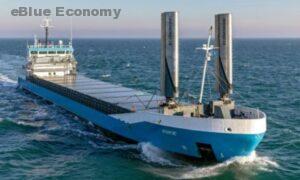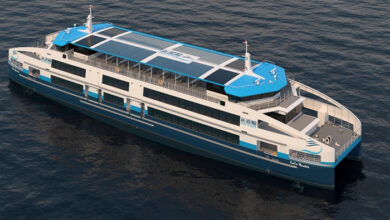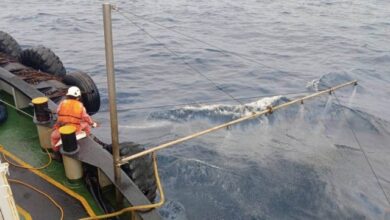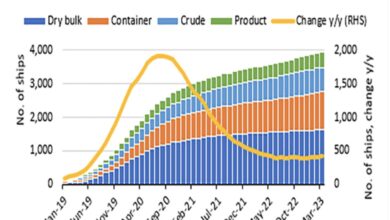
Education and policy in regards to safety and security must constantly review their activities. With the rise of automation, AI, data-driven practices
Interview by :Magdy Sadek and Shreen Elgohry
IWSA is an independent organisation, run for and by our members
Building of new, wind-assist and primary wind vessels will be very important for the future of shipping in a carbon-constrained future
Gavin Allwright has been the Secretary of the International Windship Association (IWSA) www.wind-ship.org since it was established in 2014, this not-for-profit grouping of maritime wind propulsion companies. He also leads the policy and finance work streams, requiring regular attendance at IMO, OECD and EU meetings. He currently sits on the UN International Maritime Organisation (IMO) Maritime Technology Cooperation Centres (MTCC) stakeholder’s advisory committee and is a non-executive board member on the World Wind Energy Association (WWEA). He has also chaired the Royal Institute of Naval Architect’s (RINA) Shipping Efficiency & Wind Propulsion conferences along with the last four years of the Natural Propulsion Seminar as part of Blueweek hosted by the Marine Research Institute of the Netherlands (MARIN).
He is currently an advisor on a number of EU and international joint industry and research projects, including: WASP, WiSP, STEERER, VTAS, Decarbonising UK Freight and the Post Carbon Logistics Center.
Gavin Allwright has been the Secretary of the International Windship Association (IWSA) www.wind-ship.org since it was established in 2014, this not-for-profit grouping of maritime wind propulsion companies. He also leads the policy and finance work streams, requiring regular attendance at IMO, OECD and EU meetings.
He currently sits on the UN International Maritime Organisation (IMO) Maritime Technology Cooperation Centres (MTCC) stakeholder’s advisory committee and is a non-executive board member on the World Wind Energy Association (WWEA).
He has also chaired the Royal Institute of Naval Architect’s (RINA) Shipping Efficiency & Wind Propulsion conferences along with the last four years of the Natural Propulsion Seminar as part of Blueweek hosted by the Marine Research Institute of the Netherlands (MARIN).
He is currently an advisor on a number of EU and international joint industry and research projects, including: WASP, WiSP, STEERER, VTAS, Decarbonising UK Freight and the Post Carbon Logistics Center.
Gavin holds a Masters degree in Sustainable Development, specialising in small scale sustainable shipping and logistics in developing countries. He lectures on the development of wind propulsion and sustainable shipping as a visiting lecturer at a number of universities, including the UN World Maritime University, Malmo, Sweden.
In an excluive interview with the eBlueeconomy site, Gavin said that the future for the maritime sector is one of creating a new equilibrium, one that creates sustainability.
He added that with the rise of automation, AI, data-driven practices etc. we must as an industry be consistent and maintain standards but also be flexible and quick of foot to ensure that as an industry we keep up with these changes.
He furthered to say that the international wind ship association was founded 6 years ago in response to the need to bring together a very fragmented group of technology providers and support organizations to build the credibility and understanding of wind energy as a key direct energy source for the shipping industry.
He stressed that the association functions as a not-for-profit organization with no share holders and they are viewed by the industry as a form of ‘trade association’ promoting the use of wind propulsion solutions for commercial shipping.
Moreover Mr. Gavin gave detailed answers to many detailed questions in his exclusive interview with the eBlueeconomy
This is a challenging question to answer
How do you see the future of maritime transport industries in light of the fourth industrial revolution and after Covid 19 ?!
This is a challenging question to answer and could take an entire article itself. The future for the maritime sector is one of creating a new equilibrium, one that creates sustainability. This term sustainability balances both efficiency and resilience. In the past, efficiency has been pretty much a sole focus, however the tensions and stresses that the fourth industrial revolution and the Covid crisis expose speak to the need to develop a much more flexible, digitally aligned, modular and circular economy focused industry. The decoupling of the maritime industry from carbon will be the defining trend of the coming two or three decades.
Ships enter the age of automation . Does this mean that IMO should review the maritime educational curricula and the laws regulating maritime security and safety
I think that the IMO does some excellent work in this arena, but to answer your question, all institutions involved with
education and policy in regards to safety and security must constantly review their activities. With the rise of automation, AI, data-driven practices etc. we must as an industry be consistent and maintain standards but also be flexible and quick of foot to ensure that as an industry we keep up with these changes, ideally being in front of the curve
Strategy and implementation mechanisms
The International Windship Association: How was it thought of? What is its working strategy and implementation mechanisms?
The association was founded 6 years ago in response to the need to bring together a very fragmented group of technology providers and support organisations to build the credibility and understanding of wind energy as a key direct energy source for the shipping industry. There were a large number of barriers to this at the time, one of the primary ones being perception and trust in the technologies being developed. IWSA has been working on multiple fronts to build that credibility and the secretariat and members have followed a
collaborative approach around creating a level playing field for the basket of technologies in pre-competitive areas – communications has been key in changing perception, the establishment of a network of projects, engineers and specialists has helped create an innovation ecosystem, market development activities include outreach to shipping and logistics stakeholders and providing market information and updates. Policy is increasingly important and we are active in the IMO, EU forums and project and policy brief national governments too. This involves contributing to decarbonisation pathway developments, the appraisal of regulations as they pertain to wind propulsion etc. Finally we also engage with the technical issues, and this is primarily done through our specialist members and ongoing projects at the industry and regional levels.
Smart ships limit piracy operations
Does the presence of smart ships limit piracy operations or is it a phenomenon that will survive after adopting its tools with modern technologies ?!
This is an area that I have limited knowledge. I would suggest that strengthening vessels by the adoption of ‘smart’ practices
will have a significant impact on piracy, however this practice has been around for centuries and is highly adaptive, therefore while larger vessels will be safer, the attention will turn to smaller, less protected shipping and could morph into cyber-piracy or other areas of vulnerability.
Cyber security
Mentioning piracy, how do you view the piracy of the IMO website, as well as international shipping companies such as CMA, and others ?! Cyber security, is it considerably important in the maritime and logistic transport industry ?!
Again, while this is not an area of expertise, I would rank cyber-security high on priorities. As shipping climbs the technology ladder, those vulnerabilities and the impact of breaches or failures in security become enhanced. This is also another area of resilience and one that needs to be tackled collectively, and that is not just from within shipping. We are part of a huge logistics chain, with a huge number of stakeholders interacting with one another, therefore the breach of security in one sector, or with one player can act as
a back door or vulnerability for the wider system – as they say the ‘tide raises all ships’ and therefore cargo owners, freight companies, ports and shipping companies across the port have to adopt cross sector approaches to ensure a robust system.
Conditions for membership
What are the conditions for membership in this organization ?! What is the number of its members ?! Are there members from the Arab region or Egypt ?!
Our membership has grown significantly over the past few years, growing from 12 founding members primarily drawn from the technology side to over 130 members (members, associate members and registered supporters) covering the entire ecosystem, including technology providers, R&D and testing centres, engineering companies, shipowners, shipbuilding, class, NGOs and academia. The full membership category is reserved for companies and organisations that have a significant stake in wind propulsion development, either through development of technology, testing and validation or installations of wind propulsion rigs. Our
associate members and registered supporter levels enable membership for all other companies, organisations and individuals that share our goals and objectives and wish to support those.
We are a member-driven not-for-profit so our membership is a vital component in the organisation and we welcome members from the Arab region and Egypt, though currently we have very few from the region, but a number of our members are active in trying to build their networks in the region.
IWSA is an independent organization
Does that organization operate under the IMO auspices ?! Or is it among NGOs ?! What is the kind of relation and the form of cooperation with international maritime organizations ?!
IWSA is an independent organisation, run for and by our members. We have an annually elected board and I have the privilege to have been retained as the Secretary general of the organisation since it’s founding. We function as a not-for-
profit organisation with no share holders and we are viewed by the industry as a form of ‘trade association’ promoting the use of wind propulsion solutions for commercial shipping. As mentioned earlier, we interact, advise and collaborate on quite a few different levels with different organisations.
With the IMO we are active as a member of the MTCC network stakeholder advisory committee assisting with the dissemination of information on decarbonisation to the five developing region centres. We also attend many of the decarbonisation debates and help brief delegations on the recent developments in wind propulsion technologies and we have an application for full consultative status pending at IMO. We are also active in a number of EU projects and advisory activities, currently as an partner on a EU Interreg project for outfitting retrofit wind technologies and we are represented on the STEE RER Green Shipping Expert Group. On top of these, we also have many meetings and briefing contacts with both at the national government level and also at the shipping organisation level to update the sector on
developments. IWSA also works in the more general field of renewable energy, it has recently become a member of the IRENA Coalition for Action and I sit as a non-executive board member of the World Wind Energy Association
Projects of a future or recent
Do you have projects of a future or recent work plan of the organization ?!
Yes, we have a quite extensive work plan going forward. Next year will be a critical year of development for both the shipping industry in general and wind propulsion in particular. We are focused on three main areas, firstly the policy and regulation arena, where our activities and advisory role is expanding to ensure that decision makers are in possession of the correct information as it pertains to wind propulsion solutions and potential along with challenging some of the remaining barriers to wind. Secondly, we are developing a number of regional hubs, clusters or centres of excellence that help to galvanise activity worldwide – there are currently hubs in various stages of development in Europe, North America, South Pacific and Asia, however these
need development and we see these (and other hubs) as a critical network to nurture over the next 2-3 years. Finally, on the innovation and technology side, we will be rolling out an accelerator program over the next year or so which will help support, test, validate and assist with bringing to market of wind propulsion technologies, newbuild vessels and other support and facilitating systems.
Important obstacles
What are the most important obstacles that hinder the mechanisms of your work ?!
Breaking this down into two areas, firstly the main barriers to wind propulsion uptake now are three fold – perception, demonstrators and investment
On perception we are seeing a big change in the market, there are a growing number of very large players that are now actively engaging with the wind propulsion sector, from Maersk tankers, MOL, “K”-lines, CMES, Louis Dreyfus Armateurs to Cargil, Vale and Renault to name just a few. The perception of wind propulsion as an old technology is
dissipating. There is a clearer understanding in the decarbonisation transition that as an energy source it has clear advantages – it is abundant, available worldwide today, it is supplied without the new for costly new infrastructure and is delivered to the point of use on the vessel for free, for the lifetime of the vessel. It can’t deliver the full energy requirement of a ship, but it is compatible with all other forms of propulsion energy.
We are still tackling the view that decarbonisation in shipping should follow a ‘green fuel’ only approach, whereas we focus on ‘green propulsion’ approach, which has the potential to unlock a new paradigm of shipping propulsion.
The lack of demonstrator vessels has been a significant obstacle to date, however this again is changing. There will be 12 large wind-assist vessels in operation by the end of 2020, from small general cargo vessels, to bulkers, ferries and tankers up to VLCC size. This number is supplemented with a further 20+ small sail cargo and small cruise vessels under sail, along with some traditional sail vessels in the Indian
ocean and elsewhere. The number of large vessels will double each year up to 2023 with the existing pipeline of envisaged installations, though additional contracts will undoubtably be signed in the interim.
Finally, investment is always key, and due to the low fuel price and other CAPEX related issues, new technology is always in need of further investment. However there are changes in this situation too, viewing wind propulsion as a service, i.e. leasing systems or shifting CAPEX costs in pay-as-you-save financial models are ways in the future to help accelerate the flow of capital. Of course the implementation of a ring fenced carbon levy would return the proceeds of that tax to shipowners to help reduce the costs of installing low carbon technologies, similar to the Norwegian Nox fund would also be a significant boost.
Of course our members are very supportive, but we need to be reaching a wider set of stakeholders too.
Have you thought about an exploratory visit to the Arab region or Egypt to generate propaganda for the organization ?!
From a Secretariat point of view, we have certainly looked at this, indeed in 2018-19 we organised a North America and East Asia tour and we had plans this year to extend that but with the COVID situation that was not possible, I am hoping that from the middle of next year, such activities will be possible. Of course from a members perspective a number of members regularly visit the region for conferences and meetings.
The future for wind energy
Finally, do you see that it is the future for wind energy under the laws of carbon emissions when manufacturing ships ?!
The building of new, wind-assist and primary wind vessels will be very important for the future of shipping in a carbon-constrained future. As optimised wind-assist vessels these could generate a third of the propulsive energy they need from the wind, if these are primary wind vessel, then that energy can be double or more. That means that using today’s technology, we can already deliver carbon neutral vessels at a fairly large scale.
Under current IMO regulations such as EEDI, there is less incentive from a compliance perspective as these frameworks were primarily designed with only fuel and fuel efficiency in mind. We are working to propose adjustments to the existing ways of calculating wind energy’s contribution and to ensure that future regulation and procedures integrate wind propulsion at their core.
















